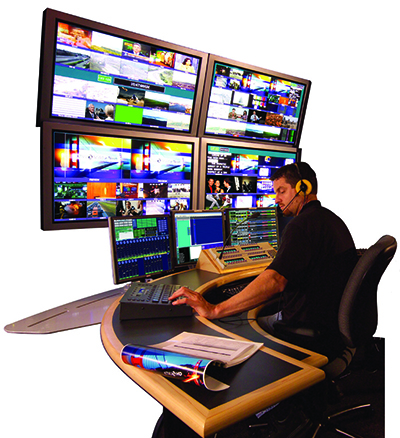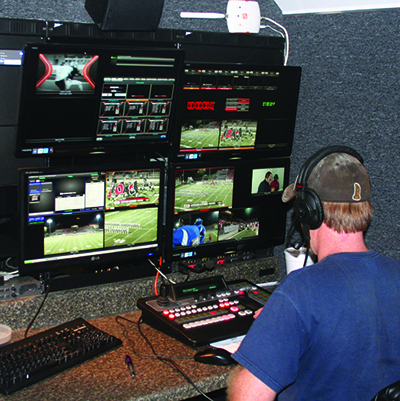Integrated Production Systems For Big Jobs

Grass Valley Ignite integrated production system OTTAWA—In Wichita, Kan., NBC affiliate KSNW-TV produces its daily newscasts using a single operator running a Grass Valley Ignite integrated production system. That’s one person handling switching, serving video clips, managing supers/ titles, and controlling the station’s three Sony-box cameras on Vinten pedestals.
In Austin, Texas, MyNetwork affiliate KBVO covers high school football and basketball using a two person crew, doing the entire broadcast out of a 20-foot box trailer. Using a Broadcast Pix Granite 1000 Video Control integrated production system, the crew manages switching, serving clips, creating supers/titles, and ingesting feeds from up to eight Sony EX3 HD cameras.
“One person is the director/switcher, while the other runs replays and audio,” said Korey Wisland, KBVO’s production manager. Granted, the output “doesn’t look like a network broadcast,” he said. “But it’s very, very close.”
Nearby, the Waco City Cable Channel, WCCC-TV, relies on a Rushworks VDESK integrated production system—and up to five Sony BRC-H700 robotic HD cameras— to cover local meetings and a range of other events. According to Larry Holze, the City of Waco’s director of municipal information, VDESK has allowed his threeperson production staff to boost their programming output. “There’s no way we could have done all this in the days of manual A/B rolling,” Holze said.
These are just some of the many users of integrated production systems. By choosing systems that integrate switching, video clip control, supers/titles, audio, and a range of other functions normally handled by separate operators, integrated production systems allow one or two people to do the work of large crews.
RANGE OF OPTIONS
With broadcasters and other video producers having to produce more content with less staff, integrated production systems are becoming increasingly popular. Not surprisingly, vendors such as Broadcast Pix, For-A, Grass Valley, NewTek and Rushworks have stepped in to meet this demand.

KBVO in Austin, Texas covers high school football and basketball using aBroadcast Pix Granite 1000 Video Control integrated production system. At KBVO, Broadcast Pix’s Granite 1000 performs numerous production functions. Beyond the capabilities noted above, the Granite 1000 can control robotic cameras, create virtual sets using green/blue screens for up to eight cameras, and link the character generator to external sources, to support automated generation of sports scores and other graphics.
Get the TV Tech Newsletter
The professional video industry's #1 source for news, trends and product and tech information. Sign up below.
“We’re seeing a lot of interest in the Granite 1000 not just for TV, but for radio as well,” said Ken Swanton, CEO and co-founder of the Billerica, Mass.-based company. “A lot of radio stations want to serve video from their broadcast to the Web, without adding extra staff. Producing their shows using the Granite 1000 makes this possible.”
At For-A, “our Hanabi line of production switchers, including the HVS-300, HVS-350, HVS-390 and the HVS-4000, are currently integrated with clip players such as the MBP- 100SX and character generators such as the VTW-330HS,” said Pedro Silvestre, For- A America’s sales director. “We also have developed SmartDirect, a new standalone production system that offers a powerful, easy to use, template-based CG generator with audio and video playback.”
Grass Valley’s Ignite Scalable Automated Production System is designed to let one person produce live newscasts and events on their own by putting all of the control room’s functions at their fingertips. This includes video and audio switching; serving video clips, graphics and titles, and integrating with up to 32 external devices, including robotic cameras. The Ignite switcher can be set up to handle anywhere from one to four M/Es, with a maximum of 96 video and 96 audio outputs. The whole system can then be controlled using a Grass Valley QUICbox programmable controller, which can be controlled via keyboard or touchscreen.
“Our Ignite integrated production system really lets broadcasters do more with less,” said Eric DuFossé, Grass Valley’s vice president of product marketing. “This includes providing more content for the Web while producing TV programming, which more and more broadcasters are doing.”
SINGLE PERSON OPERATION
First introduced in 2005, NewTek’s TriCaster integrated production system, “was designed from the beginning to allow one person to create live television programming,” said Philip Nelson, senior vice president of artist and media relations at the San Antonio, Texas-based company. TriCaster is now used by ESPN, Fox News, MTV, and NBC, as well as video producers such as the NBA, NFL and Miss Universe Pageant.
NewTek’s latest TriCasters include the $4,995 entry-level TriCaster 40 and the $39,995 top-end TriCaster 8000. “The Tri- Caster 8000 model is the most integrated and customizable multicamera video production system on the market,” said Phillips. “It delivers virtually limitless scalability with third-party router support, recordable macros that can be triggered simultaneously, and extensive effects and graphics capabilities with eight M/E rows.”
Rushworks’ integrated production systems “are designed specifically for single person operation,” said Rush Beesley, president and founder of Rushworks in Flower Mound, Texas. “The total integration of camera control with production switching, recording and streaming is what makes these solutions unique in the marketplace.” Rushwork systems are used by government broadcasters, and are also suited for churches and performance spaces.
Rushworks currently offers three integrated production systems. The VDESK PRO (4/8/12 inputs) is a touchscreen system that combines integrated PTZ cameras with switching, graphics, encoding and streaming. The VDESK LTD (4/8) is a small chassis model supports encoding and streaming, but no output. The REMO PRO (4/8) uses the same software feature set as the VDESK PRO, but is built into a ruggedized portable chassis for remote production.
For broadcasters accustomed to multiperson crews, moving to an integrated production system may seem intimidating. But for operations where money is tight, these systems can allow broadcasters to expand their production options and look good while doing so. Better yet, running such systems is “easier than you would think,” said KBVO’s Wisland.
James Careless is an award-winning journalist who has written for TV Technology since the 1990s. He has covered HDTV from the days of the six competing HDTV formats that led to the 1993 Grand Alliance, and onwards through ATSC 3.0 and OTT. He also writes for Radio World, along with other publications in aerospace, defense, public safety, streaming media, plus the amusement park industry for something different.

